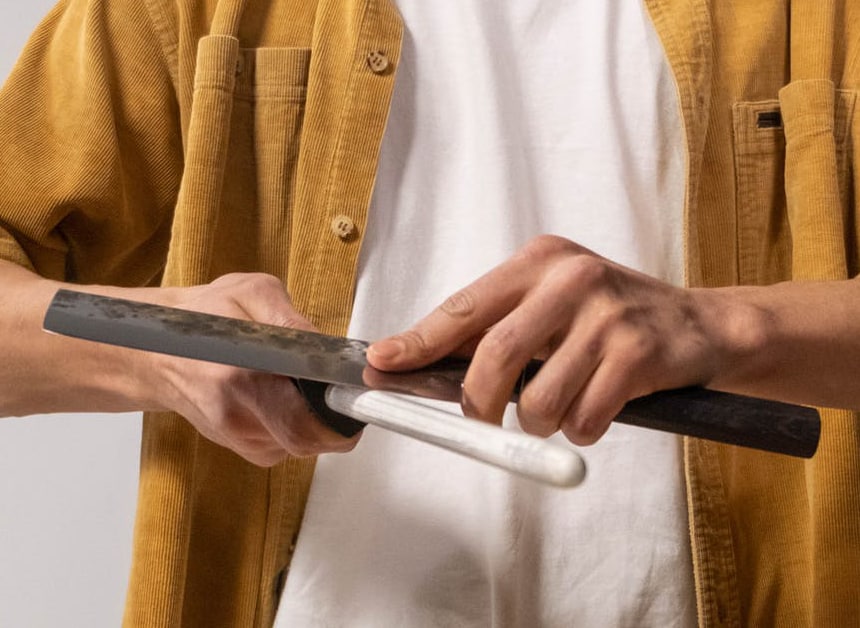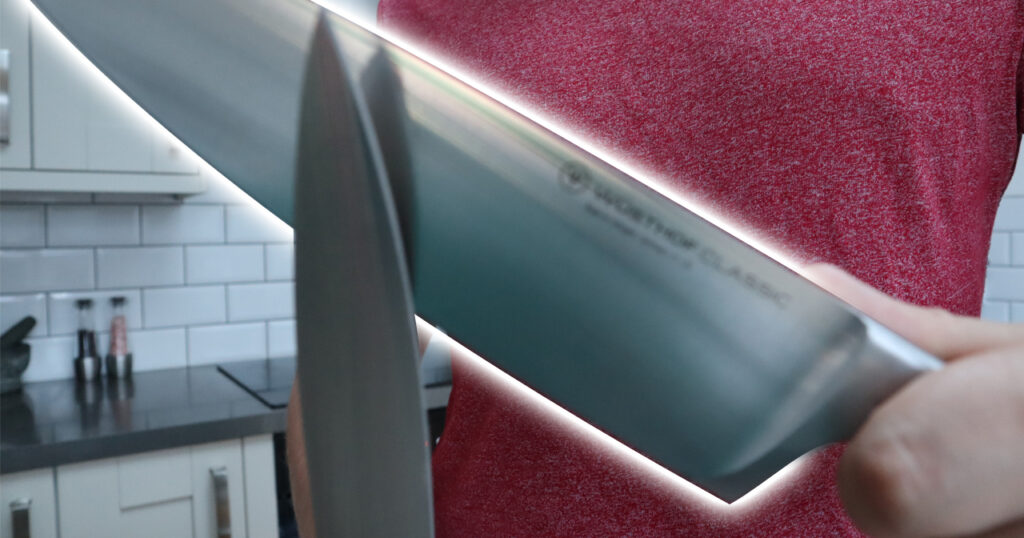
A good quality chef’s knife is one of the most important tools in your kitchen. A chef’s knife is by far the most used knife in most home kitchens. That’s why it’s important to take care of your chef’s knife, to keep it sharp and to make it last as long as possible.
A well-kept knife is a pleasure to use, making cooking a joy, a poorly kept knife can be very frustrating, leading to more hacking at the food than easily slicing through.
A honing steel is easily the most vital piece of equipment to keep your knife in good order. But many home cooks don’t really understand what a honing steel actually does, nevermind how to use one.
Honing a knife shouldn’t only be a practice restrained to the professional kitchen. It’s easy to do and will make your knife last much longer, saving you money in the long run.
When using a honing steel you should hold your knife at a 15 – 20 degree angle to the steel. Gently but quickly glide the blade down the steel to realign the edge on each side. Repeat this a maximum of 6 times for each side. You should hone your knife frequently, typically after every few uses.
Before you dive into the full description of how to hone a knife, it‘s important to understand why you need to hone a knife, so let’s start with discussing what a honing steel actually does do, and even more vital, what it doesn’t do.
What is a honing steel?
Most people have seen a honing steel but the majority probably won’t have realised it. Honing steels are commonly, and incorrectly, referred to as sharpening steels. There is a distinct difference between the two and honing steels are much more common.
If you don’t already have a honing steel yourself you’ll likely have seen it in a friend or relatives kitchen, perhaps hidden away in a drawer, perhaps proudly sitting in a knife block.
A honing steel is a long thin cylindrical steel rod with a handle at one end. The steel will taper down at the exposed end, not to a sharp point but generally to a rounded tip.
A honing steel is generally around 12 inches long or 30 centimetres.
The cylindrical surface of the steel is rough and, as you would imagine with a steel rod, it is extremely hard and will not bend under normal force.
Honing steels are often mistakenly called sharpening steels, even by professional chefs. Honing steels are not the same tool as a sharpening rod and both have a different purpose.
You’ll need to use a honing steel far more frequently than an actual sharpening rod. Let’s discuss why honing steels and sharpening rods are different.
Honing doesn’t technically sharpen a knife
There is quite a lot of confusion around what honing a knife does, and what it doesn’t do.
Typically people believe that a honing steel is used for sharpening your knife and that scraping the knife up and down the edge of the rod will produce a razor-sharp finish.
Sharpening a knife is not what a honing steel is for.
A honing steel doesn’t actually help sharpen your knives. Its purpose is to straighten your knife.
This doesn’t mean that your knife would be visibly wonky, but the edge of a knife is so fine that when you use it and it impacts on the cutting board, or any other hard surface, tiny sections on the edge of the knife will literally fold over.
Imagine the blade of your knife as similar to the teeth of a saw, with use the tiny little teeth fold over and go out of alignment with the rest of the blade.
These may be microscopic at first and it’s impossible to stop it from happening, it’s just part of using a chef’s knife. Hitting bones in meat, hard services and cutting boards will all cause small folds on your blade edge.
A honing steel forces this folded steel back up and into straight alignment again. A honing steel is all about realignment.
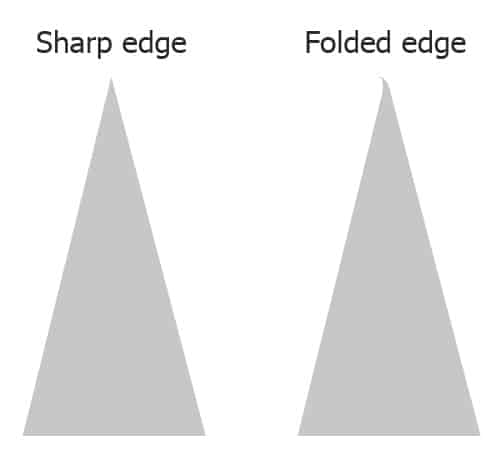
Sharpening a knife does something very different to the knife edge. When you sharpen a knife you remove a layer of the blade to provide a fresh, sharp edge. Honing a knife is not about removing any of the blade, just aligning what’s already there.
By virtue of being realigned the edge will feel sharper to the user, but the edge hasn’t actually been technically sharpened at all.
It’s a very important distinction because you don’t need to sharpen your chef’s knife nearly as frequently as you need to hone it.
Therefore, you can be making a large error by frequently using a sharpening rod, thinking it’s a honing steel as you will remove a lot of steel from your blade unnecessarily.
Equally, it’s no good using a honing rod infrequently thinking that you’re sharpening the blade as it will be seriously out of alignment and the honing steel might not be effective enough.
Difference between honing steels and sharpening rods
Above I’ve explained that honing realigns the blade and sharpening removes a layer of the blade to unveil a fresh sharp edge.
Remember that to remove a layer of the steel the rod must be made of a harder material. That really helps in understanding which tool will hone and which will sharpen.
To make sure you use the right tool follow this guide:
- Honing steel – Made from steel, so it has an equal strength as steel blades
- Sharpening rod – Made from harder materials such as diamond and ceramic
Now that we know which tool to use for honing, let’s take a look at how often you should hone your chef’s knife.
How often should I hone my chef’s knife?
You should hone your knife on a much more regular basis than sharpening.
I would recommend that you hone your chef’s knife a minimum of every three uses.
If you keep up this regular use of the honing steel you’ll find that your knife stays in top condition for much longer and it should be able to go quite a long time before it needs to be sharpened.
How often should I sharpen my chef’s knife?
Sharpening the knife only needs to be done a couple of times a year, depending on use.
If you find that your knife is still blunt after honing then it’s probably time to sharpen it.
How to hone a chef’s knife
Now that we understand the theory, let’s look into the best practice for honing your chef’s knife.
Honing a chef’s knife is all about the angle. You’re trying to realign the blade to its original angle. So let’s begin with finding the correct angle to hone your chef’s knife.
Find the correct angle when honing a knife
The objective of honing a knife is to carefully realign any part of the edge which has folded.
For that reason, you should be careful not to hold a knife at a high angle against the steel when honing. This could actually cause the blade to fold more, resulting in a blunter feeling knife.
So you should use a gentle angle which will guide the blade back into place. This is quite easy to imagine as you are basically trying to match the angle of the blade edge itself. Typically western chef’s knives are designed at a 15-20 degree angle for the blade.
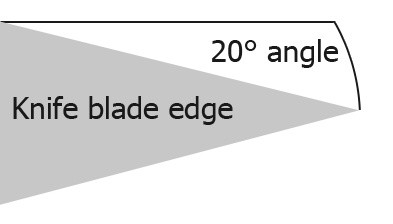
Aim to hold the knife at a 15 – 20 degree angle to the honing steel.
This should ensure that the steel is gently realigning the folded sections of the blade to the original angle and not causing any further imperfections.
This angle isn’t too hard to achieve. If you hold your knife at a right angle to the honing steel, that’ll be 90 degrees, tilt the knife to half that distance and it’ll be 45 degrees, half again and you’ll be around 20 degrees.
Different techniques to hone your knife
There are two different approaches to honing your knife, for both you want to continue using the 15 – 20 degree angle whilst honing your knife.
For the beginner user it may be preferable to use the supported method, so let’s discuss that one first.
The supported honing technique – Best for beginners
This technique makes it a little easier to keep that 15 – 20 degree angle and is probably the one which you’ve seen least often, if ever. But it can be very useful.
Use a hard, non-slip surface to place the end of the steel on. Holding the steel by the handle in a vertical position, like a tower.
This gives the steel stability and a fixed position for you to work on. This is especially useful for elderly users who may find it more difficult to keep the blade at the correct angle in the free hand position.
Being with the knife at the handle of the steel, furthest away from the hard surface.
Tilt the knife to the 15 – 20 degree angle to the steel and gently but quickly glide the knife down the honing steel, towards the end.
Start this at the handle end of the knife, pulling away so that the tip of the blade is in contact with the steel by the time you get to the end of the steel.
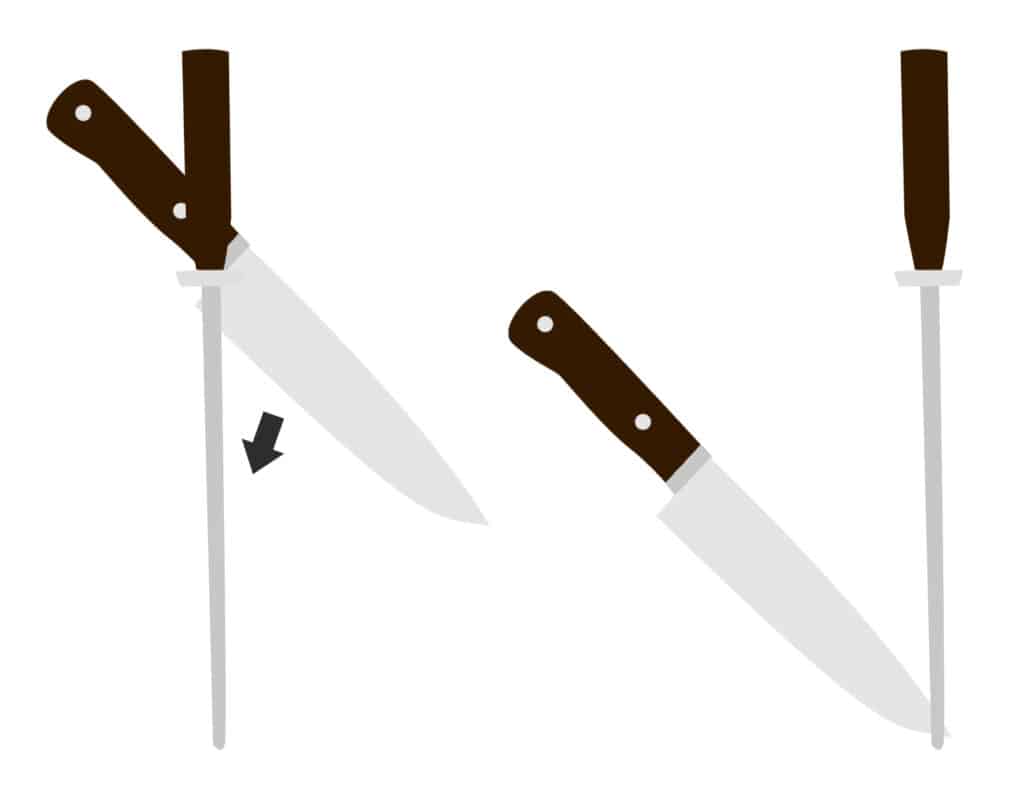
Repeat this on the other side of the blade using the opposite side of the steel.
Repeat this 5-10 times and your knife should be honed. The more often you hone your knife the fewer times you will need, and the better your knife will keep.
If you find that you need to hone each side more than 6 times then your knife probably needs to be sharpened. Honing more than 6 times per side will not really yield any further improvement.
There’s a great section in this video which clearly explains the supported technique:
The freehand honing technique
Even though the supported method is the best for beginners, the freehand method is probably the one you have seen the most.
Hold the steel in one hand with the knife in the dominant hand. Make sure that your hand is holding the handle of the steel only, below the butt of the steel. The butt will make sure your fingers are fully protected from the blade, absolutely do not hold the rod of the steel whilst honing your knife!
Being with the knife at the handle end of the steel.
Tilt the knife to the 15 – 20 degree angle to the steel and gently but quickly glide the knife down the steel, towards the end of the steel.
Start this at the handle end of the knife, pulling away so that the tip of the blade is in contact with the steel by the time you get to the end of the steel.
Repeat this on the other side of the blade using the opposite side of the steel.
Repeat this 5-10 times and your knife should be honed. The more often you hone your knife the fewer times you will need, and the better your knife will keep.
If you find that you need to hone each side more than 6 times then your knife probably needs to be sharpened. Honing more than 6 times a side will not really yield any further improvement.
Top ‘Tip‘
You should try to stop honing before the tip of the honing steel reaches the tip of the knife. This is quite tricky to do but try and practice, honing the tip of the knife can result in the tip becoming rounded. That’s not a disaster but it’s better to avoid it if you can.
Constant honing is key to keeping a good knife
You may be honing the knife at the perfect angle, but when it comes to keeping a knife in good order nothing beats constant maintenance. It’s no good honing at the correct angle if you’ve used your knife seventy-six times in between honing.
A honing steel is a great piece of equipment because it’s so quick and easy to use and it really will make your knife last much much longer.
It really is worth honing your knives frequently, it only takes a minute and it’s by far the best way of maintaining them. I advise honing your knife after every three uses at least.
Eventually, your knife will need to be sharpened, because a honing steel just will not do this job.
If your knife still feels blunt after honing then it’s time to get it sharpened, you can either do this yourself or send it off to be done professionally.
But remember, to sharpen your knife effectively you will need a sharpening rod, or sharpening stone. Don’t be misled by ‘steel’ sharpening rods as they simply will not sharpen your knife effectively since the steel rod is only as hard as your steel knife.
